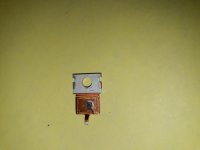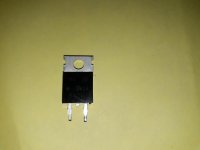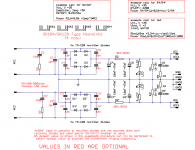Can anyone tell if this failed MUR860G diode is fake. One of 8 diodes exploded, others went open or shorted!
The failure occurred in my DIY version of the most excellent CRC Power Supply (Class A amplifier) at power up. There was a very dishearteningly sharp pop, followed by the associated smell of nastyburningwhitchesasshole.
I’m using the CRC power supply with my Cordell Super Gainclone Super Gainclone With Klever Klipper Based on Cordell Design.
The MUR860G datasheet shows the Nonrepetitive Peak Surge Current at 100A under (Surge applied at rated load conditions halfwave, single phase, 60 Hz). The CRC power supply uses dual full wave rectification (8 diodes). I guess that’s 120Hz?
I have since replaced all the diodes with MUR1560’s which are rated at 15A, with a Nonrepetitive Peak Surge Current of 150A and everything is working again.
I’m not sure if the diodes failed because of the filter caps initial charging current surge at turn on, or if it’s because they’re fake. Every time I turn the amp on I’m just waiting for another pop!
My transformer is an 300VA Antek Toroid AS-3222 and the power supply caps are CRC 10000uF with 0.5 Ohm 20W resistors in between them. I’ve got no soft start with my PS and amp configuration as I didn’t think it was necessary with less than 500VA toroid and 10000uF caps on the CRC input.
Any advice regarding why the the diodes failed is very much appreciated and thanks for taking the time to read all this blurb!
The schematic is from Prasis' CRC BOM CRC Power Supply (Class A amplifier)
The failure occurred in my DIY version of the most excellent CRC Power Supply (Class A amplifier) at power up. There was a very dishearteningly sharp pop, followed by the associated smell of nastyburningwhitchesasshole.
I’m using the CRC power supply with my Cordell Super Gainclone Super Gainclone With Klever Klipper Based on Cordell Design.
The MUR860G datasheet shows the Nonrepetitive Peak Surge Current at 100A under (Surge applied at rated load conditions halfwave, single phase, 60 Hz). The CRC power supply uses dual full wave rectification (8 diodes). I guess that’s 120Hz?
I have since replaced all the diodes with MUR1560’s which are rated at 15A, with a Nonrepetitive Peak Surge Current of 150A and everything is working again.
I’m not sure if the diodes failed because of the filter caps initial charging current surge at turn on, or if it’s because they’re fake. Every time I turn the amp on I’m just waiting for another pop!
My transformer is an 300VA Antek Toroid AS-3222 and the power supply caps are CRC 10000uF with 0.5 Ohm 20W resistors in between them. I’ve got no soft start with my PS and amp configuration as I didn’t think it was necessary with less than 500VA toroid and 10000uF caps on the CRC input.
Any advice regarding why the the diodes failed is very much appreciated and thanks for taking the time to read all this blurb!
The schematic is from Prasis' CRC BOM CRC Power Supply (Class A amplifier)
Attachments
MUR860: Power Rectifier, Ultra-Fast Recovery, Switch-mode, 8 A, 600 V
For chip amps, the prefered diode is the Onsemi MUR860G. The logo is normally printed just above the left pin. Yours looks fake to me.
For chip amps, the prefered diode is the Onsemi MUR860G. The logo is normally printed just above the left pin. Yours looks fake to me.
Last edited:
If it says "cheap", "Chinese" or "ebay" then there's a good chance it is fake.
Its a bit of a lottery.
Save yourself a whole load of grief and buy from likes of RS and Farnell.
Not the cheapest but they are most reliable.
I have used bridge rectifier with 35amp max current with similar set up to you with no problems. I would go with you bought fakes.
What tends to happen with fakes is the die is a lot smaller so just wont take the same voltage or current.
Its a bit of a lottery.
Save yourself a whole load of grief and buy from likes of RS and Farnell.
Not the cheapest but they are most reliable.
I have used bridge rectifier with 35amp max current with similar set up to you with no problems. I would go with you bought fakes.
What tends to happen with fakes is the die is a lot smaller so just wont take the same voltage or current.
Yes, I agree having been bitten a few times already.
Its not that I cant afford the parts from the reputable companies but the fact that I object to paying the minimum of $40 US from Mouser Mexico in order to get free shipping.
To give you an example. qty 1 MUR860G @ $1.14 with shipping and tax makes $36.12
To get free shipping, I would have to buy 43 diodes @ $.952 making a total of $40.95 plus 16% tax making $47.5 total.
It cost me almost the same to buy 1 diode as it cost to buy 43 diodes!
I usually wait to buy parts until I have a BOM that amounts to the $40. When I cant wait for want of a couple of parts is when I've tended to use the MercadoLibre Mexico lottery
At the end of the day, I need to put a value on my time and effort. Building a good sounding amp and risking blowing it up for a set of diodes that'r going to cost me $47.5 is not that tough of a choice, just very frustrating.
Time to bite the bullet I guess!
Its not that I cant afford the parts from the reputable companies but the fact that I object to paying the minimum of $40 US from Mouser Mexico in order to get free shipping.
To give you an example. qty 1 MUR860G @ $1.14 with shipping and tax makes $36.12
To get free shipping, I would have to buy 43 diodes @ $.952 making a total of $40.95 plus 16% tax making $47.5 total.
It cost me almost the same to buy 1 diode as it cost to buy 43 diodes!
I usually wait to buy parts until I have a BOM that amounts to the $40. When I cant wait for want of a couple of parts is when I've tended to use the MercadoLibre Mexico lottery
At the end of the day, I need to put a value on my time and effort. Building a good sounding amp and risking blowing it up for a set of diodes that'r going to cost me $47.5 is not that tough of a choice, just very frustrating.
Time to bite the bullet I guess!
That failed diode might not have been fake. It’s not very hard for a toroid to develop more than 100 amps into an empty capacitor. If I were using FREDs with a 50/60 Hz toroid I would use 60 amp units, not 8 amp. An 8 amp diode would only need to dissipate 16 watts under normal operation. That die would easily handle 16 watts. Not only that, but fakes would never use that copper leadframe. That’s something you find in real Fairchild/ON TO-220’s.
That failed diode might not have been fake. It’s not very hard for a toroid to develop more than 100 amps into an empty capacitor. If I were using FREDs with a 50/60 Hz toroid I would use 60 amp units, not 8 amp. An 8 amp diode would only need to dissipate 16 watts under normal operation. That die would easily handle 16 watts. Not only that, but fakes would never use that copper leadframe. That’s something you find in real Fairchild/ON TO-220’s.
Does the moment I flip the switch have a part to play in the total current? i.e. switching on when the capacitors are fully discharged and the AC input voltage is at it's peak leads to a higher current surge
Do you mean something like Vishay VS-EPH6007L-N3 with 60A Fwd Current and 520A Max Surge? $3.03 each for ten or more.
Find Electronic Components | Mouser
Last edited:
I went for MUR1560 for my (also most excellent) CRC PSU and haven't had any problems so far.
Nice!
I just hope the ones I used are genuine. I'm sure I'll find out soon enough

Does the moment I flip the switch have a part to play in the total current? i.e. switching on when the capacitors are fully discharged and the AC input voltage is at it's peak leads to a higher current surge
Do you mean something like Vishay VS-EPH6007L-N3 with 60A Fwd Current and 520A Max Surge? $3.03 each for ten or more.
Yes, those. They can take 5 times the current at switch-on. More than many of the big 60 Hz brick rectifiers. But notice it is only 5 times more, not 8X as the continuous current rating would suggest. Amp for amp, fast rectifiers are not as rugged as the slow ones.
Using a zero-crossing solid state relay (that uses a triac) is one method of making a soft-start. That insures you never turn it on at the worst time.
Using a zero-crossing solid state relay (that uses a triac) is one method of making a soft-start. That insures you never turn it on at the worst time.
Unfortunately, I can't squeeze a single item more into the chassis, so the relay/ triac wouldn't fit.
If the diodes go again, I'll probably purchase the highest rated diodes available from Mouser.
- Status
- This old topic is closed. If you want to reopen this topic, contact a moderator using the "Report Post" button.
- Home
- Design & Build
- Parts
- Is This Failed MUR860G Diode A Fake?


